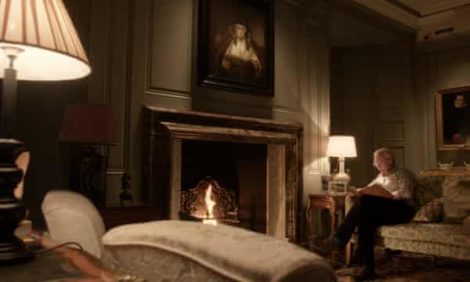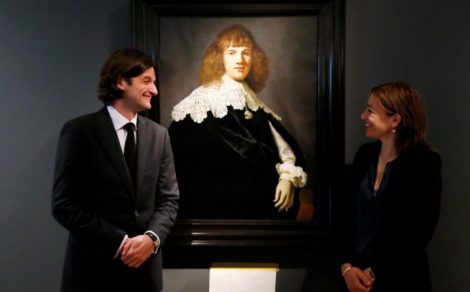My Rembrandt
Front Row at the Movies by Shirrel Rhoades
[mr_rating_result]I once bought an etching by Sir Francis Seymour Haden for $15 at a small antique shop in the Caribbean. The owner had just returned from a buying trip to London and it was among the unsorted goods he’d brought back. Having a degree in art, I knew that Haden was the brother-in-law of James McNeill Whistler – so I could brag, “I don’t have ‘Whistler’s Mother’ but I’ve got his brother-in-law.”
Little did I realize that some experts consider Hayden to be a master at chiaroscuro, second only to Rembrandt. It was quite a find.
So recently I bought an etching by Rembrandt. Known as “Medea: or the Marriage of Jason and Creusa,” it was created in 1648, although my image was pulled much later. It pictures a chamber filled with light and shadows, a reflection the Old Master’s style.
But don’t get the wrong impression. My etching is a multiple original, one of many struck from Rembrandt’s copper plate, so the value is not what you’d think.
 To remind you, Rembrandt Harmensz van Rijn (1606–69) was a Dutch painter best known for his shadowy portraits and self-portraits. Also, he was quite a printmaker. Art historians say he transformed the etching process from a relatively new reproductive technique into a true art form.
To remind you, Rembrandt Harmensz van Rijn (1606–69) was a Dutch painter best known for his shadowy portraits and self-portraits. Also, he was quite a printmaker. Art historians say he transformed the etching process from a relatively new reproductive technique into a true art form.
There are about 300 existing Rembrandts paintings, not counting multiple originals of his 399 etchings, and various drawings. An estimated 2,000 paintings are falsely attributed to him.
My fascination with Rembrandt led me to watch a new documentary called “My Rembrandt” (original title: “Mijn Rembrandt”), a movie that focuses on several individuals who own a genuine Rembrandt painting. As one viewer observed, “The title should very definitely have been ‘Living with a Rembrandt.’”
“My Rembrandt” provides insights into what makes the work of this Dutch master technically extraordinary. But mostly it examines “why different people are so deeply affected by his oeuvre, or a specific work.”
Dutch filmmaker Oeke Hoogendijk (“The Saved,” the 4-part TV series “The New Rijksmuseum”) takes us inside the stately European homes of people who actually own Rembrandt paintings.
The tour begins at the 80,000-acre estate of Scotland’s Duke of Buccleuch. His prize, a portrait of an older woman reading. It has been in the family for generations. He likes to sit under it with a good book. Even though it’s not for sale, the director of the Rijksmuseum has his eye on this Rembrandt masterpiece. “Never say never,” he says as he helps the Duke look for a better place to display it in the huge manor house.
Then we meet Jan Six XI, a member of Amsterdam’s aristocracy. Rembrandt painted the first Jan Six in 1654 and the family still has the portrait along with a number of others. Himself an art dealer, Jan Eleven is determined to find other Rembrandts that have yet not been authenticated.
Then we have Thomas S. Kaplan, the investment billionaire who used his fortune to snap up Rembrandts. “Prior to 2003, it had never occurred to me that one could buy a painting by Rembrandt,” he gushes. Fascinated by Dutch art of the Golden Age, he set off on a collecting spree, snapping up over 200 paintings.
 “I had no desire to become a collector of paintings,” he tells us. “I rejected the concept out of hand … saying I would never become a vulgar materialist … and within two years Daphne and I were acquiring on average a painting a week, for five years.” As he describes it, he “launched a raid on Rembrandts.”
“I had no desire to become a collector of paintings,” he tells us. “I rejected the concept out of hand … saying I would never become a vulgar materialist … and within two years Daphne and I were acquiring on average a painting a week, for five years.” As he describes it, he “launched a raid on Rembrandts.”
Now he has so many that he allows museums to exhibit his collection, taking them “from the private domain and returning them back to the public domain,” he says as we follow him on a tour through the Louvre.
And then there’s Baron Eric de Rothschild, an aristocrat who seeks to raise money to help his brother pay off some very large gift taxes. Willing to part with a pair of Rembrandts, full-height portraits of a “monsieur and madam” that flank his bed, the Baron’s asking price is $160 million. We watch as the Rijksmuseum and The Louvre squabble over acquiring them.
All these stories are intertwined, the camera shifting from subject to subject and back again, picturing the men and their paintings with loving detail, a sharp eye, and obvious artistic appreciation.
However, the discovery of a Rembrandt by Jan Six takes the forefront. We watch as art scholar Ernst van de Wetering studies the quality of light shining through the subject’s starched linen collar and pointing out how Rembrandt paints hair. Determined to prove his eye for art, Six consults others. Yes, it is declared, “Portrait of a Young Gentleman” is a Rembrandt.
This is quite a coup, in that Six bought the painting at a Christie’s auction for only $185,000. Not recognized as an original, it having been attributed to the “circle of Rembrandt.”
At this point, the documentary’s excitement level is heightened by an ethics scandal, a wrecked friendship, and power plays as an associate accuses Jan Six of stealing the undiscovered Rembrandt from him in the bidding.
Six got the boost to his reputation as an art dealer as well as owning the painting.
Essentially, “My Rembrandt” gives us a series of portraits of people obsessed with the Dutch master. But at heart it is about the paintings.
You art lovers can catch “My Rembrandt” at virtual movie series being sponsored by local theaters – like Tropic Cinema – or on such streaming video platforms as Amazon Prime, Vudu, and Apple TV.
“What unites all these people is their maniacal passion for Rembrandt,” says Variety. The New York Times calls these Rembrandt owners “faintly obsessive.”
Nevertheless, I’d like to be one. A big chiaroscuro oil painting with broad strokes and large swatches of colors would look just great over my fireplace, right?
As the Tropic reopens with caution, please familiarize yourself with the protective house rules and procedures. In particular, please note that all tickets must be purchased online. Got questions? Email info@tropiccinema.com.
Email Shirrel: srhoades@aol.com


Ratings & Comments
[mr_rating_form]